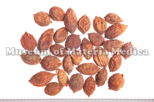Bitter Cardamon

|
TMPW No.:16211 |
| Synonym | |
| Latin name | Alpiniae Fructus |
| Botanical source: Family name | Zingiberaceae |
| Botanical source: Plant name | Alpinia oxyphylla Miquel (IPNI:795356-1) |
| Part used | Fruit |
| Empirical criteria for quality selection | Good one is large and light yellow or light yellowish-brown. It has a strong odor. (TN) |
| Constituents | Monoterpenoids: 1,8-Cineole, β-Pinene, p-Cymene, Terpinen-4-ol; Camphor Sesquiterpenoids: Zingiberene, β-Salinene, β-Caryophyllene, α-Humulene, α-Copaene, Nootkatone; Zingiberol Flavonoids: tectochrysin, chrysin, izalpinin, 3,5-dihydroxy-7, 4'-dimethoxyflavone Diarylheptanoids: Yakuchinone A(1-(4'-hydroxy-3'-methoxyphenyl)-7-phenyl-3-heptanone), Yakuchinone B |
| Pharmacological effects | Antiulcer (acetone extract, nootkatone) |
| Indications | As an aromatic stomachic and antiflatulent, it is used for functional decline of digestive system, indigestion, diarrhea due to indigestion, and nervous diarrhea. It is used as well as Amomi Semen. |
| Diseases | Abdominal pain, Chill, Dyspepsia, Diarrhea, Anorexia, Slaver, Spermatorrhea, Frequent urination |
| Formulas | |
| Meridian tropism | Spleen, kidney |
| Property | Warm |
| Flavor | Acrid/pungent |
| Classification in "Shen-non Ben-cao Jing" | |
| TCM: Classification | Yang tonics |
| TCM: Medicinal effects | To warm the spleen, relieve diarrhea and arrest excessive discharge of saliva, and to warm the kidney, and arrest seminal discharge and abnormal urination. For cold syndrome of the spleen characterized by diarrhea, abnormal pain with cold sensation, and salivation, cold syndrome of the kidney characterized by enuresis, frequent urination, seminal emission and whitish discharge from urethra. |
| Remarks | Listed in the Japanese Pharmacopoeia 18th ed. |
| References | TN: T. Namba & Y. Tsuda ed., Outline of Pharmacognosy, a Textbook, 3rd ed., Nankodo Co., Ltd., Tokyo, 1998. |
